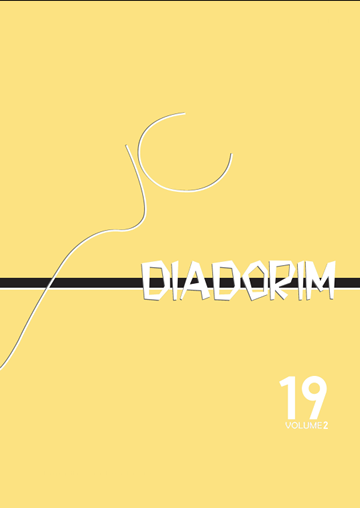Anaphoric Direct Object as Referential Strategy: Didactic Mediation for Basic Education
DOI:
https://doi.org/10.35520/diadorim.2017.v19n2a10182Keywords:
Study and use of anaphoric direct object, Continuous linguistic variation, Referencing strategies, Collaborative Teaching.Abstract
This is an action research (TRIPP, 2005) for the study and use of the anaphoric direct object in the seventh grade of middle school. In Brazilian Portuguese, this category can be performed by means of clitics, noun phrases, personal pronouns and by a zero anaphora (the null direct object), being therefore the direct object a variable realization. Schools generally focus on the study of clitics, based on the memorization of terminologies and on decontextualized activities that do not reflect its use. Te objective of this work is precisely to develop didactic activities that allow the student to deal with the four strategies of realization of the direct anaphoric object, depending on the linguistic event in which the students are inserted. It is a didactic mediation based on the collaborative approach of teaching and learning (BEHRENS, 2013) associated to two linguistic theories: i) the linguistic theory of referencing (KOCH, 2006; WERNECK, 2015, CAVALCANTE, 2010) and ii) the linguistic theory of continuums (BORTONI-RICARDO, 2004, 2005), with emphasis on the continuous orality-literacy.References
ANTUNES, I. Lutar com palavras -- Coesão e coerência. 1ª edição. São Paulo: Parábola, 2005.
AVERBUG, M. Objeto direto anafórico e sujeito pronominal na escrita de estudantes. Dissertação de Mestrado. Rio de Janeiro: UFRJ/FL, 2000, mimeo.
BAGNO, M. Gramática de bolso do português brasileiro. São Paulo: Parábola Editora, 2013.
BEHRENS, M. A. O paradigma emergente e a prática pedagógica. 6. ed. Petrópolis: Vozes, 2013.
BORTONI-RICARDO,S.M. Nós cheguemos na escola, e agora? Sociolinguística & Educação. São Paulo: Parábola Editorial, 2005.
______. Educação em Língua Materna- Sociolinguística na Sala de Aula. São Paulo: Parábola Editorial, 2004.
CASTILHO, A.T.de. A língua falada no ensino de português. São Paulo: Contexto, 2004.
______. Nova gramática do português brasileiro. São Paulo: Contexto.2010.
CAVALCANTE, M. Metadiscursidade, Argumentação e Referenciação. Estudos Linguísticos, São Paulo, 38 (3): 345-354, set.-dez. 2009.
CORRÊA, V.R. O objeto direto nulo no português do Brasil. Dissertação de Mestrado, Unicamp, 1992.
COSTA, W. A. Do título ao texto/ Do texto ao título: o processo de estabilização da referência em notícias do jornal Meia Hora. Dissertação de Doutorado. Niterói -- RJ: UFF, 2013.
CYRINO, S. Observações sobre a mudança diacrônica no português do Brasil: objeto nulo e clíticos. In: ROBERTS, I. e KATO, M.(orgs). Português brasileiro: uma viagem diacrônica do português brasileiro, Campinas: Editora da Unicamp,1993.
______. NUNES, J., PAGOTTO, E. Complementação In: KATO, Mary. e NASCIMENTO, do Milton. Gramática do português culto falado no Brasil. Campinas, SP: Editora da Unicamp, 2009.
DUARTE, M.E.L. Variação e sintaxe: clítico acusativo, pronome lexical e categoria vazia no português do Brasil. Dissertação de Mestrado. São Paulo: PUC, 1986.
______. Do pronome nulo ao pronome pleno: a trajetória do sujeito no português do Brasil. In: KATO, M. A.; ROBERTS, I. (Orgs.). Português brasileiro: uma viagem diacrônica. Campinas: Pontes.1993.
______. O Papel da Sociolinguística na descrição da Gramática da Escrita Contemporânea. In: Tavares e Martins (Orgs.) Contribuições da Sociolinguística e da Linguística Histórica para o ensino de língua portuguesa, Natal: Editora da UFRN p. 117-143. 2013.
FARACO, C.A. Norma culta brasileira -- desatando alguns nós. São Paulo: Parábola Editorial. 2009.
FREIRE, G.C. A realização do acusativo e do dativo anafóricos de terceira pessoa na escrita brasileira e lusitana. Tese de Doutorado. Rio de Janeiro -- RJ: UFRJ, 2005.
FREIRE, G.C. A realização do acusativo e do dativo anafóricos de terceira pessoa na escrita brasileira e lusitana. Tese de Doutorado. Rio de Janeiro -- RJ: UFRJ, 2005.
KOCK, I. e ELIAS, V. Ler e Compreender: estratégias de produção textual. 2ª Ed., São Paulo: Contexto, 2014.
MARCUSCHI, L. A. Da fala para a escrita -- atividades de retextualização. 8. ed. São Paulo: Cortez, 2001. ______. Gêneros textuais: definição e funcionalidade. Rio de Janeiro: Editora Lucerna, 2002.
RAPOSO, Eduardo P. Teoria da gramática. A faculdade da linguagem. Lisboa: Editorial Caminho, AS, 1992.
SOUSA, R.M.de e MACHADO, V. R. Coesão referencial: aspectos morfossintáticos e semânticos. In: BORTONI-RICARDO, S.M., SOUSA, R., FREITAS, V., MACHADO, V. Por que a Escola Não Ensina Gramática Assim. 1ª Ed., São Paulo: Parábola Editora, p. 19-45, 2014.
THIOLLENT, M. Metodologia da pesquisa-ação. São Paulo: Cortez, Autores associados, 1988. TRIPP, D. Pesquisa-ação: uma introdução metodológica. Educação e Pesquisa: São Paulo, v. 31, n. 3, 2005, p. 443-466.
WEINREICH, Uriel; LABOV, William; HERZOG, Marvin. Fundamentos empíricos para uma teoria da mudança linguística. Tradução de Marcos Bagno; revisão técnica WEINREICH; HERZOG; LABOV, 2006 [1968].
WERNECK, L. ReVEL na Escola: Referenciação. ReVEL, vol. 13, n. 25, 2015. Disponível em: www. revel. inf.br Acesso em 20 de novembro de 2016.
Downloads
Published
Issue
Section
License
Copyright transfer -- Authorization to publication
If the submitted article is approved for publication, it is already agreed that the author authorizes UFRJ to reproduce it and publish it in Diadorim: revista de estudos linguísticos e literários, the terms "reproduction" and "publication" being understood as defined respectively by items VI and I of article 5 of Law 9610/98. The article can be accessed both by the World Wide Web (WWW) and by the printed version, with free consultation and reproduction of a copy of the article for the own use of those who consult. This authorization of publication is not limited in time, and UFRJ is responsible for maintaining the identification of the author of the article.

The journal Diadorim: revista de estudos linguísticos e literários is licensed under a Creative Commons Attribuition-NonCommercial 4.0 International (CC BY-NC 4.0).

